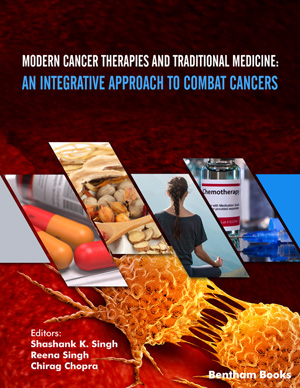
摘要
90 kDa热休克蛋白(Hsp90)是一种分子伴侣,可通过维持400多种客户蛋白的折叠,稳定,活化和降解来确保细胞蛋白水解。 Hsp90不仅对于健康细胞中的常规蛋白质维持至关重要,而且在细胞应激状态(例如癌症和神经退行性疾病)中也很重要。由于具有影响多种客户蛋白质磷酸化的能力,自1990年代初以来,抑制Hsp90一直是一种有吸引力的抗癌方法,当时研究人员在Hsp90的氨基末端确定了可治疗多种癌症的靶标。从那以后,针对分子伴侣N末端结构域的17种Hsp90抑制剂进入了临床试验。但是,到目前为止,没有一种药物被FDA批准为癌症的单一疗法。在这些试验中,在N末端域抑制Hsp90的主要局限性是剂量限制性毒性和相对较差的药代动力学特征。尽管如此,临床前和临床研究仍显示Hsp90抑制剂有效地靶向癌细胞死亡并降低了肿瘤进展,为开发新型Hsp90抑制剂提供了理论依据。在这里,我们提供了在临床试验中使用的Hsp90抑制剂的深入概述。最后,我们提出了与靶向Hsp90的羧基末端结构域以及同工型选择性抑制剂的开发相关的领域的当前变化,以绕过当前Hsp90抑制剂的陷阱并改善临床试验结果。
关键词: 癌症,伴侣蛋白,格尔德霉素,Grp94,Hsp90,新霉素,TAS-116,TRAP1。
图形摘要
[http://dx.doi.org/10.2174/138161213804143725] [PMID: 22920906]
[http://dx.doi.org/10.1038/nrc1716] [PMID: 16175177]
[http://dx.doi.org/10.1007/BF02172188]
[http://dx.doi.org/10.1073/pnas.72.3.1117] [PMID: 805422]
[http://dx.doi.org/10.1016/0014-4827(64)90147-8] [PMID: 14208747]
[http://dx.doi.org/10.1016/0022-2836(74)90447-1] [PMID: 4219221]
[PMID: 10955818]
[http://dx.doi.org/10.1016/0145-2126(92)90008-U] [PMID: 1635378]
[http://dx.doi.org/10.1016/j.bbamcr.2011.07.020] [PMID: 21840346]
[http://dx.doi.org/10.1038/nature01913] [PMID: 14508491]
[http://dx.doi.org/10.1111/j.1349-7006.1996.tb02119.x] [PMID: 8878452]
[http://dx.doi.org/10.1073/pnas.91.18.8324] [PMID: 8078881]
[http://dx.doi.org/10.1073/pnas.90.15.7074] [PMID: 7688470]
[http://dx.doi.org/10.1073/pnas.96.1.109] [PMID: 9874780]
[http://dx.doi.org/10.2174/156802609789895728] [PMID: 19860730]
[http://dx.doi.org/10.1038/nrm.2017.20] [PMID: 28429788]
[http://dx.doi.org/10.3233/JAD-2010-1221] [PMID: 20061647]
[http://dx.doi.org/10.1101/cshperspect.a009399] [PMID: 22355802]
[http://dx.doi.org/10.1097/WCO.0000000000000215] [PMID: 26110807]
[http://dx.doi.org/10.1016/S0163-7258(98)00013-8] [PMID: 9749880]
[http://dx.doi.org/10.1016/S0014-5793(04)00229-7] [PMID: 15069952]
[http://dx.doi.org/10.1016/S0092-8674(00)80314-1] [PMID: 9230303]
[http://dx.doi.org/10.1016/S1097-2765(03)00065-0] [PMID: 12667448]
[http://dx.doi.org/10.1128/MCB.14.2.1459] [PMID: 8289821]
[http://dx.doi.org/10.1016/j.bbamcr.2011.10.008] [PMID: 22062686]
[http://dx.doi.org/10.1007/978-1-4939-7477-1_29] [PMID: 29177675]
[http://dx.doi.org/10.1016/bs.acr.2015.12.001] [PMID: 26916001]
[http://dx.doi.org/10.1038/s41594-018-0177-7] [PMID: 30617298]
[http://dx.doi.org/10.2174/138161213804143617] [PMID: 22920907]
[http://dx.doi.org/10.1021/acs.biochem.9b00144] [PMID: 30869872]
[http://dx.doi.org/10.2741/4050] [PMID: 22652777]
[http://dx.doi.org/10.1016/B978-0-12-396521-9.00003-6]
[http://dx.doi.org/10.1021/jm9004708] [PMID: 20055425]
[http://dx.doi.org/10.1016/j.freeradbiomed.2010.03.001] [PMID: 20211249]
[http://dx.doi.org/10.1517/13543780903158934] [PMID: 19642950]
[http://dx.doi.org/10.1158/1078-0432.CCR-11-0562] [PMID: 21737509]
[http://dx.doi.org/10.1038/nrd894] [PMID: 12209147]
[http://dx.doi.org/10.1016/S1074-5521(01)00015-1] [PMID: 11306353]
[http://dx.doi.org/10.1016/j.chembiol.2004.03.033] [PMID: 15217611]
[http://dx.doi.org/10.1158/1535-7163.MCT-08-0758] [PMID: 19372565]
[http://dx.doi.org/10.1021/bk-2016-1239.ch003]
[http://dx.doi.org/10.1073/pnas.0903392106] [PMID: 19416831]
[http://dx.doi.org/10.1016/j.chembiol.2010.04.015] [PMID: 20659681]
[http://dx.doi.org/10.1021/jm900230j] [PMID: 19552433]
[http://dx.doi.org/10.1016/j.bmcl.2005.05.046] [PMID: 15955698]
[http://dx.doi.org/10.1021/jm701018h] [PMID: 18020435]
[http://dx.doi.org/10.1158/0008-5472.CAN-07-5256] [PMID: 18413753]
[http://dx.doi.org/10.1186/bcr1996] [PMID: 18430202]
[PMID: 21154128]
[http://dx.doi.org/10.1021/jm100060b] [PMID: 20662534]
[http://dx.doi.org/10.1021/jm100059d] [PMID: 20718493]
[http://dx.doi.org/10.1158/1078-0432.CCR-09-3112] [PMID: 20406843]
[http://dx.doi.org/10.1038/bjc.2017.302] [PMID: 28873084]
[http://dx.doi.org/10.1016/j.bmcl.2012.07.052] [PMID: 22877636]
[http://dx.doi.org/10.1158/1535-7163.MCT-12-1003] [PMID: 23538902]
[http://dx.doi.org/10.1158/1535-7163.MCT-11-0667] [PMID: 22246440]
[http://dx.doi.org/10.1158/1535-7163.MCT-14-0219] [PMID: 25416789]
[http://dx.doi.org/10.1158/1535-7163.MCT-18-0831] [PMID: 30679388]
[http://dx.doi.org/10.1074/jbc.M105568200] [PMID: 11751878]
[http://dx.doi.org/10.2174/092986708786242895] [PMID: 18991631]
[http://dx.doi.org/10.1379/1466-1268(1998)003<0100:ARBTTN>2.3.CO;2] [PMID: 9672245]
[http://dx.doi.org/10.1021/bi0497998] [PMID: 15209518]
[http://dx.doi.org/10.1074/jbc.M003701200] [PMID: 10945979]
[http://dx.doi.org/10.1074/jbc.RA118.002502] [PMID: 30792306]
[http://dx.doi.org/10.1039/C8CC07576J] [PMID: 30575826]
[http://dx.doi.org/10.1038/s41598-017-14902-y] [PMID: 29374167]
[http://dx.doi.org/10.1379/1466-1268(2004)009<0004:COHSPA>2.0.CO;2] [PMID: 15270073]
[http://dx.doi.org/10.1039/C4MD00102H] [PMID: 25328661]
[http://dx.doi.org/10.1016/j.surg.2015.07.050] [PMID: 26542767]
[http://dx.doi.org/10.1016/j.neo.2017.09.003] [PMID: 29121598]
[http://dx.doi.org/10.1016/j.canlet.2011.07.031] [PMID: 21924824]
[http://dx.doi.org/10.1245/s10434-011-1971-1] [PMID: 21837531]
[http://dx.doi.org/10.1002/chem.201504955] [PMID: 27037933]
[http://dx.doi.org/10.1016/S1065-6995(02)00256-1] [PMID: 12713799]
[http://dx.doi.org/10.3390/cells8060532] [PMID: 31163702]
[http://dx.doi.org/10.1016/j.cell.2011.02.013] [PMID: 21376230]
[http://dx.doi.org/10.1016/j.bbamcr.2011.09.009] [PMID: 21982864]
[http://dx.doi.org/10.1016/j.bbamcr.2011.10.013] [PMID: 22079671]
[http://dx.doi.org/10.1016/j.semcdb.2010.03.004] [PMID: 20223290]
[PMID: 2793869]
[http://dx.doi.org/10.1042/BJ20061867] [PMID: 17411420]
[http://dx.doi.org/10.1074/jbc.275.5.3305] [PMID: 10652318]
[http://dx.doi.org/10.1074/jbc.270.8.3574] [PMID: 7876093]
[http://dx.doi.org/10.1074/jbc.M703196200] [PMID: 17513296]
[http://dx.doi.org/10.1016/j.cmet.2013.04.019] [PMID: 23747254]
[http://dx.doi.org/10.3389/fonc.2017.00058] [PMID: 28405578]
[http://dx.doi.org/10.1186/s41038-019-0154-3] [PMID: 31143823]
[http://dx.doi.org/10.1073/pnas.0609973103] [PMID: 16371460]
[http://dx.doi.org/10.1074/jbc.M606192200] [PMID: 16973602]
[http://dx.doi.org/10.1172/JCI29715] [PMID: 17304350]
[PMID: 10510348]
[http://dx.doi.org/10.2174/1568026616666160413141613] [PMID: 27072698]
[http://dx.doi.org/10.3892/ijo.2014.2530] [PMID: 24990602]
[http://dx.doi.org/10.1200/JCO.2011.41.5851] [PMID: 22649132]
[http://dx.doi.org/10.1021/mp300138n] [PMID: 22554505]
[http://dx.doi.org/10.1158/1078-0432.CCR-11-1000] [PMID: 22215907]
[http://dx.doi.org/10.1074/jbc.M001477200] [PMID: 10816561]
[http://dx.doi.org/10.1016/j.bmcl.2006.01.086] [PMID: 16464590]
[http://dx.doi.org/10.1021/ol050580a] [PMID: 15901158]
[http://dx.doi.org/10.1021/ol900783m] [PMID: 19435295]
[http://dx.doi.org/10.1016/j.jmb.2009.03.071] [PMID: 19361515]
[http://dx.doi.org/10.1021/ja303477g] [PMID: 22642269]
[http://dx.doi.org/10.1016/j.immuni.2006.12.005] [PMID: 17275357]
[http://dx.doi.org/10.1021/acs.jmedchem.6b00085] [PMID: 27003516]
[http://dx.doi.org/10.1038/s41598-017-18344-4] [PMID: 29263415]
[http://dx.doi.org/10.1093/hmg/ddu367] [PMID: 25027323]
[http://dx.doi.org/10.1002/chem.201703398] [PMID: 28857290]
[http://dx.doi.org/10.1021/acsmedchemlett.7b00193] [PMID: 29057043]
[http://dx.doi.org/10.1038/nchembio.1335] [PMID: 23995768]
[http://dx.doi.org/10.1021/acs.jmedchem.8b00800] [PMID: 30351001]
[http://dx.doi.org/10.1016/j.bmcl.2013.11.036] [PMID: 24332488]
[http://dx.doi.org/10.1124/jpet.109.158436] [PMID: 19934398]
[http://dx.doi.org/10.1021/jm500042s] [PMID: 24673104]
[http://dx.doi.org/10.1038/s41467-017-02013-1] [PMID: 29382832]
[http://dx.doi.org/10.1016/j.ccr.2005.03.035] [PMID: 15894266]
[http://dx.doi.org/10.1016/j.bbamcr.2011.08.007] [PMID: 21878357]
[http://dx.doi.org/10.1016/j.canlet.2013.01.045] [PMID: 23376257]
[http://dx.doi.org/10.1007/s12272-015-0636-1] [PMID: 26195286]
[http://dx.doi.org/10.1021/ja511893n] [PMID: 25785725]
[http://dx.doi.org/10.1021/acs.jmedchem.7b00978] [PMID: 28816449]
























